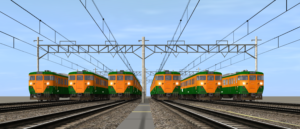
DOWNLOAD
This is a reskin of Keinchiro’s 113 Series upgraded by Hirochi. All the necessary dependencies are included in this package or are avaible on the DLS.
By the late 1950s, JNR was facing the problem of rapidly increasing ridership on inner- and outer-suburban lines, such as the Tokaido Main Line rapid services from Tokyo to Atami or the busy commuter services around Nagoya and Osaka.
At the time, these lines were primarily served by obsolete pre-war and substandard war-time stock such as the 63 and 72 Serieses, with the exception of the relatively modern (but already inadequate) 80 Series running a few Tokaido Line Services.
Until then, new stock had been introduced only for express and rapid services, with the majority of local service being left to old, rattling and uncomfortable trains.
Therefore, a new design was urgently needed.
Mostly based on the AC/DC 401 Series introduced in 1960 for Joban Line services (but also with a few element of the 153 Series for Tokaido Line Rapid Services and of the 115 Series for School Excursion Services), the first sets of the new 111 Series entered service in 1961.
They were an epocal improvement compared to the older stock: the three doors per side greatly increased the speed of boarding and alighting, the new “box seat” design (wich would become standard for JNR stock) was a farcry from the old, uncomfortable wooden benches, the disc brakes and cardan-drive motors greatly improved traction performance, and many, many more.
In short, the 111 Series was more comfortable, had a better performance, was easier to maintain and was far more versatile than the older stock.
In 1963, an improved version was introduced, simplyfing construction and using the newer, higher-performance MT54 motors (rather than the older MT46 type): the 113 Series.
The 113 Series was an improvement of the already highly successful 111 Series design. So successful, that 113 Series production started in 1963 and ended 19 years and 2943 cars later in 1982!
Being also a versatile design, the 113 Series was produced in several subserieses (such as the -1000 subseries for the Sobu Line or the -2000 subseries with improved seating for the Nagoya Area) and was itself the base for all subsequent JNR standard designs of both suburban and rapid trains, such as the 115 Series for cold areas and mountainous lines, the AC/DC “standard” 415 Series, the 169 Series and many more.
The 113 Series and it’s derivatives, togheter with the 103 Series for commuter and urban services, were part of JNR’s “new performance trains” family, a series of standardized rolling stock designs wich were designed to be as simple and economical to produce as possible, enabling a fast mass-production with a final goal of replacing all the pre-war stock in service on all but few of JNR’s lines.
With the standardizaztion and the mass production, a total just shy of 3000 cars of the 113 Series was made, and with this huge amount, the 113 Series had diffused on practically evry major line from Tokyo to Hiroshima, even coming close to run all the suburban and commuter service in the Nagoya area!
With a few exceptions (notably the Yokosuka and Sobu Lines units), 113 Series sets all wore the orange and green “Shonan Livery”, wich had been introduced by the 80 Series in 1950.
Originally intended only for Tokaido Line trains (“Shonan” is the name of a popular seaside area between Odawara and Ofuna, just south of Tokyo), it quickly became the standard livery for JNR’s suburban trains, and with the huge diffusion of 113 and 115 Serieses trains, the Shonan livery quickly became famous all across Japan.
After JNR’s privatization in 1987, the fleet of the 113 Series and it’s derivatives were split between the newly formed JR East, JR Central and JR West, with JR Shikoku inheriting and returning to service a few previously-retired 111 Series sets.
As of today, the 113 Series still survives in the Kyoto and Setouchi areas, where they’re run by JR West, but their fleet is getting thinner and thinner by the year as most trains are atleast 40 yeas old.
Even so, after many different replacements had been introduced, the 113 Series and it’s derivatives are still regarded as an icon of Japanese railways, togheter with the 0 Series Shinkansen, C62 Steam Locomotives and EF66 Electric Locomotives.
Trivia:
The Shonan livery was so influential that it inspired not one, but two JR-Group company colours: dark green for JR East and orange for JR Central.
